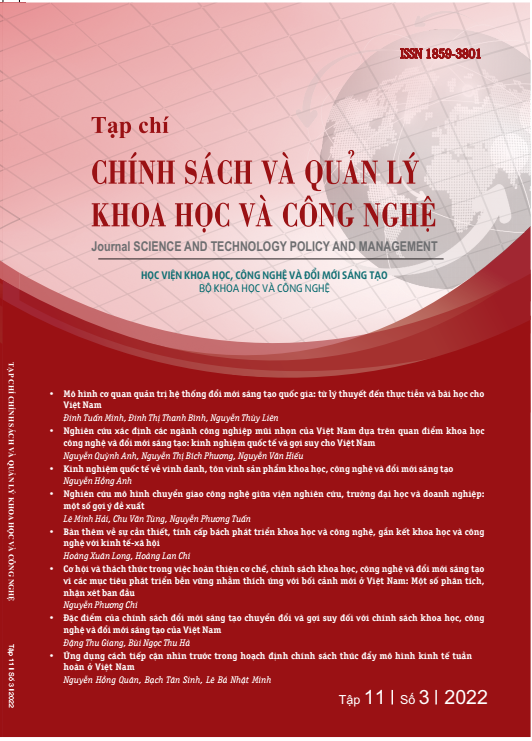A research on the technology transfer models between universities, research institutes, and companies: suggest recommendation
Keywords:
Technology transfer, Technology transfer model, Technology transfer office, Spin-offAbstract
In the knowledge-based economy, building and strengthening relationships between research institutes, universities and companies plays an extremely essential role in socio-economic development. This relationship is aimed to support each other for the mutual interest of all parties involved in. These cooperation activities are diverse, including knowledge and technology transfer (KTT) from universities, research institutes to companies. There have been many models of cooperation between each party introduced. However, each model depends on different characteristics among countries such as the United States, Mexico, etc. Some new trends in technology transfer have appeared more recently, such as technology transfer (technology transfer) through spin-off, startup companies, open innovation or collaborative research. In Vietnam, the technology transfer model through Technology transfer office, or centers is gradually being built. However, in the 4.0 era, the development of technology transfer models in Vietnam should be combined and connected with a well-invested and developed information technology platform. In addition, it is important to note that it is necessary to remove barriers to promote technology transfer through the formation of spin-off companies.
Code: 22121201
Downloads
References
Phương Nguyễn (2018). Chuyên gia gợi ý kinh nghiệm chuyển giao kết quả nghiên cứu ra thị trường. <https://vnexpress.net/chuyen-gia-goi-y-kinh-nghiem-chuyen-giao-ket-qua-nghien-cuu-ra-thi-truong-3810407.html>
Nguyễn Thu Hương và cộng sự (2022). “Xây dựng mô hình tổ chức chuyển giao công nghệ trong trường đại học tại việt nam: nghiên cứu trường hợp mô hình trung tâm chuyển giao công nghệ-trường đại học bách khoa Hà Nội”. Tạp chí Quản lý và Kinh tế quốc tế. <https://sti.vista.gov.vn/tw/Lists/TaiLieuKHCN/Attachments/ 333170/ CVv124S1432022030.pdf>
Bích Ngọc (2018). “Cò công nghệ thời 4.0”. <https://vnexpress.net/co-cong-nghe-thoi-4-0-3760812.html>
Phan Toàn Thắng (2014). Thương mại hóa nghiên cứu công nghệ: mô hình công ty spin-off. <https://ducthe.wordpress.com/2014/07/19/ thuong-mai-hoa-nghien-cuu-cong-nghe-mo-hinh-cong-ty-spin-off/>
Lê Văn (2017). Những con số “biết nói” về giáo dục đại học Việt Nam. <https://vietnamnet.vn/nhung-con-so-biet-noi-ve-giao-duc-dai-hoc-viet-nam-389870.html>
Đinh Văn Toàn (2020). Tổ chức quản lý trong trường đại học trước yêu cầu đổi mới quản trị đại học và khởi nghiệp đổi mới sáng tạo. <http://hvcsnd.edu.vn/nghien-cuu-trao-doi/dai-hoc-40/to-chuc-quan-ly-trong-truong-dai-hoc-truoc-yeu-cau-doi-moi-quan-tri-dai-hoc-va-khoi-nghiep-doi-moi-sang-tao-6230>
Abd Wahab, S., et al. (2011). “A Review on the Technology Transfer Models, Knowledge-Based and Organizational Learning Models on Technology Transfer”. European Journal of Social Sciences 10.
Bradley, R., et al. (2013). “Models and Methods of University Technology Transfer”. Foundations and Trends® in Entrepreneurship 9: 571-650.
Bessant, J. and D. Francis (2005). “Transferring soft technologies: exploring adaptive theory”. International Journal of Technology Management 4: 93-112.
Cameron, E. H. (1960). Samuel Slater, Father of American Manufactures, [Freeport, Me.]: B. Wheelwright Company.
Donald, M. (1993). “Précis of Origins of the modern mind: Three stages in the evolution of culture and cognition”. Behavioral and Brain Sciences 16(4): 737-748.
Devine, M. D., et al. (1987). “Government supported industry-university research centers: Issues for successful technology transfer”. The Journal of Technology Transfer 12(1): 27-37.
Gibson, D. V. and R. W. Smilor (1991). “Key variables in technology transfer: A field-study based empirical analysis”. Journal of Engineering and Technology Management 8(3): 287-312.
Heinzl, J., et al. (2008). “Austrian higher education institutions' idiosyncrasies and technology transfer system”. Proceedings of the European and Mediterranean Conference on Information Systems, EMCIS 2008.
Irwin, H. and E. More (1991). “Technology transfer and communication: lessons from Silicon Valley, Route 128, Carolina's Research Triangle and hi-tech Texas”. Journal of Information Science 17(5): 273-280.
Necoechea-Mondragón, H., et al. (2013). “A Conceptual Model of Technology Transfer for Public Universities in Mexico”. Journal of Technology Management and Innovation 8: 24-35.
Siegel, D. S., et al. (2003). “Assessing the impact of organizational practices on the relative productivity of university technology transfer offices: an exploratory study”. Research Policy 32(1): 27-48.
Sung, T. K. and D. Gibson (2000). “Knowledge and technology transfer: levels and key factors”. Proceedings of 4th International Conference on Technology Policy and Innovation.
Downloads
Published
How to Cite
Issue
Section
License
Authors who publish with this journal agree to the following terms:
- Authors retain copyright and grant the journal right of first publication with the work simultaneously licensed under a Creative Commons Attribution License that allows others to share the work with an acknowledgement of the work's authorship and initial publication in this journal.
- Authors are able to enter into separate, additional contractual arrangements for the non-exclusive distribution of the journal's published version of the work (e.g., post it to an institutional repository or publish it in a book), with an acknowledgement of its initial publication in this journal.
- Authors are permitted and encouraged to post their work online (e.g., in institutional repositories or on their website) prior to and during the submission process, as it can lead to productive exchanges, as well as earlier and greater citation of published work (See The Effect of Open Access).

